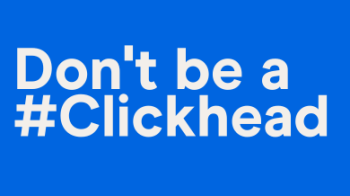We Are All Clickheads
Dale Lovell, Co-Founder of ADYOULIKE
Dale Lovell, tells a story of the impact that clickthrough rates can have, and why we fallback on CTR
Let me tell you a story. It will be familiar to anyone in digital advertising, I think. A year or so ago a large media agency booked a large campaign, for a large advertiser, with us in the UK.
We asked the client for KPIs. This was the response:
"They just want to reach as many people as possible. Viewability is key. But reach is what we want across premium publishers. The client website is really basic and the client knows the creative/landing pages we are running are not the most ‘clickable."
“Great,” we said. So we set up the campaign with reach in mind.
Fast forward 48 hours later. The all-too familiar agency email - sent BCC so you knew all vendors were getting it. It read:
“We are reviewing daily performance and the CTR isn’t where it needs to be. Please come back to us by end of the day with an update on what measures you are undertaking to improve on this. Otherwise we’ll have to pull and reassign budget.”
Thus started another familiar cycle for any ad tech vendor following the ‘agency threat’ of a pulled budget. It was another late night for our adops team - who had been optimising towards a different goal. All avoidable. All because of acting, as the IAB UK stated recently, like a ‘clickhead’.
The sites chosen had relatively good CTR, but it wasn’t our main KPI. We weren’t optimising for CTR after all. We were optimising for reach and viewability. The agency had confirmed this.
The above should ring true to everyone along the media food chain. We all say CTR doesn’t matter. We tell everyone who will listen that it doesn’t matter and we shout loud that no one cares about those ‘old school’ metrics. Then we act differently.
CTR is the split personality metric of media. I’m guilty of acting like a Clickhead at times - I’ve been known to berate a publisher for crap CTR myself - abused turned abuser. The reality is we are all Clickheads: vendors, agencies, advertisers, publishers.
Why do we fall back on CTR so often?
It’s simply engrained into the digital ecosystem. I’ve spent nearly 20 years in media working on or towards a CTR of some sort or other. We all know it’s limitations. We all want something better. But what?
The beauty of CTR is that everyone can grasp the basic argument behind it. It makes sense. It’s a blunt way to ascertain whether your ads were interesting or not.
Forget for a second that CTR can be gamed. Now imagine explaining the concept of CTR to a 97 year old, or maybe even an 8 year old. She’d grasp the gist of it I suspect. Now try and explain to her the basic mechanics of a brand uplift study, third-party attribution modelling or viewability criteria. It’s quite hard to imagine, isn’t it?
That’s the challenge many marketers face in explaining digital marketing effectiveness in boardrooms. This is why CTR is used, and is still used. It’s basic. It takes base level digital marketing acumen to understand.
Change is good for the industry. Change will come on the CTR front. But real change will only really happen when we can agree as an industry – and agree to create - a new simple, standardised attribution model for what digital advertising success looks like. Something akin to the Gross Rating Point (GRP) of TV land, perhaps. I’ll leave wiser people than myself to work that one out, but whatever the metric, it needs to be blunt and easy enough for almost everyone to be able to understand it. Otherwise, we are going to be Clickheads all of us for a fair while longer.
Written by
Dale Lovell, Co-Founder of ADYOULIKE
Topics
Related content
Why we’ll keep calling out clicks until it clicks
Learn moreWorried you might be a #Clickhead? We’re here to help
Learn more10 questions buyers of attention measurement should be asking - and why they’re important
Learn moreIAB US releases intrinsic in-game measurement guidelines for public comment
Learn more
Rediscover the joy of digital advertising
Champion connections instead of clicks. Capture audiences' imaginations, not just their attention. Boldly move to your own beat instead of letting tech set the pace. It’s time to rediscover the joy of digital.



